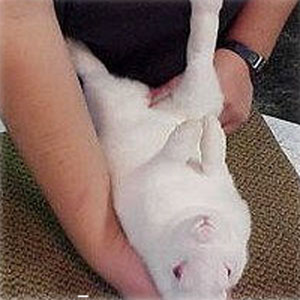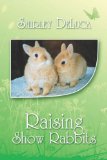Backyard Rabbit Keeping, Part 14/15 – Showing
If you would like to get involved, join the club of the breed of your choice, or let your children join – these clubs are particularly kind to young exhibitors. In this way your knowledge will quickly build up. Breeding for showing can get very complicated and, in fact, it can be well out of the realm of self-sufficiency, but there is still an element of backyarding about it. Very rarely do you find a large producer who exhibits rabbits. The Fancy are dedicated and extremely knowledgeable, but they are nearly always ‘in a small way’ with their livestock.
An article about rabbits is hardly complete without a mention of showing because the Fancy forms such a large proportion of rabbit keepers. You may not wish to show your backyard rabbits but if one day you produce, by chance, a fine specimen of your chosen breed, and you have an element of competition in your system, then you may find yourself trying your luck at a local show – and why not? Regulars are always pleased to see new faces.
First of all, study the standards for your breed; the various points are given in the appropriate breed handbook. Then, if a winner turns up, you will at least be able to recognize it. For example, there are many rules as to how the black color should be arranged on the Dutch; the black on the nose should be clear of whiskers and so on. Of course the general conformation and condition of the rabbit counts, but it is born with certain color markings and these are very important in showing. I recently visited a Dutch breeder and he showed me what he fondly hoped would be a future champion – a tiny rabbit three days old.
The English is a spotted rabbit, but any old spots will not do; they must be arranged in a definite way, and they should be as perfectly round as possible. The English rabbit’s nose should have a butterfly mark in black on it, the famous ‘butterfly smut’.
 Not long ago I dropped in at a rabbit show in a strange district, not knowing anybody. Within five minutes I was deep in conversation about rabbits. Once you have asked a question of a fancier, it is very difficult to get away.
Not long ago I dropped in at a rabbit show in a strange district, not knowing anybody. Within five minutes I was deep in conversation about rabbits. Once you have asked a question of a fancier, it is very difficult to get away.
At this show, the conversation turned to feeding and the younger people admitted, almost sheepishly, to feeding pellets because they save so much time. But they all still use plenty of hay. It appears that pellets are not always the foolproof consistent feed that they should be; there can be great variation from one batch to the next and exhibitors have found themselves in trouble, with scours breaking out just before a show. (To be fair to pellet manufacturers, in an effort to keep prices down they have to hunt about for their ingredients and although the final analysis of the food turns out the same, they are often forced to use varying ingredients to arrive at it, and the rabbits notice these changes.)
It is when the talk turns to breeding that it gets really involved, as I said before. You are basically trying to breed from animals which complement each other; for example, if your doe has a certain fault, say her spots are not round, then your chosen buck will be particularly strong on that point. With luck, you may manage to breed a rabbit that shows the good points of both parents.
There are those who say that it is not possible to combine showing with the commercial aspects of rabbit keeping. This may be so for the extremists of either persuasion, but I see no reason why a certain amount of showing should not be combined with useful rabbit keeping. Treatment of doe and young ones can be just the same as for ordinary rabbits, but if one of your ducklings should turn into a swan, so much the better.
Show rabbits are perhaps weaned a little later than usual at, say, six or eight weeks, but this depends on the breeder. The old hands have their pet systems. I think that the litters from ‘fancy’ rabbits tend to be smaller, so that fewer and bigger rabbits will be weaned.
Rabbits which are to be shown should be handled regularly, and taken out of their hutches frequently and put on a table. They soon get used to this and as they have to sit quietly on the judging table for quite a while when they are shown, it’s a good thing for them to do.
They are usually kept in hutches on their own, separate from others but able to see them. Often show rabbits live in outside hutches, although they may have shutters up on a cold winter night. Plenty of bedding is given to keep them really clean – the younger fanciers like wire floors for the white breeds for this reason. It is difficult to keep a white rabbit snowy without a lot of attention. Groundsel and chicory are fed to get the coat into its prime.
 The old guard used to give their rabbits special food before a show; dark secrets were whispered behind locked doors. Like old-fashioned farmers, they believed that their animals benefited from warm food, and who is to say that they were wrong? Although of course they were only lukewarm at most; to give hot food to an animal is cruel. The mashes were made from barley meal mixed up with hot boiled linseed, and dried off with bran. Linseed (from flax) is a very oily substance and gives a shine to the coat. Cattle exhibitors used it a lot.
The old guard used to give their rabbits special food before a show; dark secrets were whispered behind locked doors. Like old-fashioned farmers, they believed that their animals benefited from warm food, and who is to say that they were wrong? Although of course they were only lukewarm at most; to give hot food to an animal is cruel. The mashes were made from barley meal mixed up with hot boiled linseed, and dried off with bran. Linseed (from flax) is a very oily substance and gives a shine to the coat. Cattle exhibitors used it a lot.
Commercial breeders send their stock all over the country in cardboard boxes these days, but fanciers stick to the wooden traveling boxes with ventilation holes and a leather strap. The latest gadget in this line is a traveling box which doubles as a cage for the show. The side lets down to reveal a wire front.
Exhibitors are always grooming their rabbits. They brush them regularly, which keeps the fur soft and glossy and also acts like a massage treatment to prevent flabby rabbits. This was probably more of a necessity when they were giving all those high-powered mashes! But a really good show rabbit is bright, alert, fit and obviously proud of itself. It seems that grooming can do a lot to produce this feeling of well being.
Nearer to the time of the show, when the rabbits are nicely out of the molt, the old fanciers used to stop feeding mash and replace it with whole oats and soaked dried peas. And some fanatics gave their surprised animals a raw egg just before the event.
Rabbits can get rather dirty at times; I have mentioned the problem of keeping the white breeds clean. Stains can be removed with corn flour, brushed in and then out again – a sort of dry shampoo. Fanciers ‘wash’ a scruffy rabbit by grooming it vigorously with wet hands which have just been washed in warm water containing mild soap plus a little glycerin. (You can’t actually bath a rabbit.) They go on grooming with their hands until the rabbit is perfectly dry again, and shining clean. Then the fur is polished off with that final blessing – a silk handkerchief.
There are disqualifications to watch for when showing rabbits. Such things as ill health, crooked legs, sore pads are obvious ones. There are also some color faults, varying according to breed, and also odd-coloured eyes.
Another reminder; if you want to show, the rabbits must wear the official British Rabbit Council rabbit rings. No other identification will do in this country. So if you think of showing a youngster, slip a ring onto its leg before it gets too old, just in case it grows up into a handsome show rabbit.
- Why Why Keep Rabbits?
- Rabbits Past and Present
- Some Basic Information
- Making a Start
- Housing
- Feeding
- Growing Crops for Rabbits
- Breeding
- Health
- Harvesting the Wild Rabbits
- The Harvest
- Using Rabbit Meat
- Fur Production
- Showing
- Angoras
   |
Leave a Reply